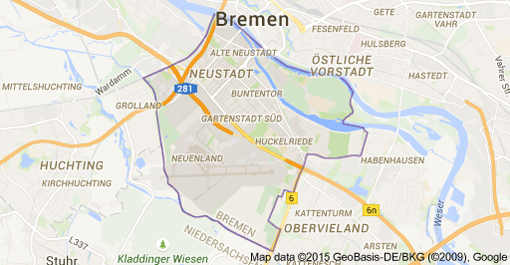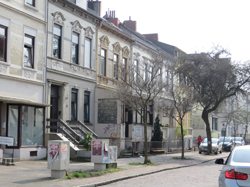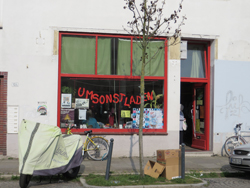Neustadt

Neustadt lies south of Bremen city, on the left side of the Weser river, directly opposite the city centre. There are three bridges connecting the quarter to Bremen’s old city. The quarter is made up of 8 sub-districts: Alte Neustadt, Buntentor, Gartenstadt Süd, Hohentor, Huckelriede, Neuenland, Neustadt und Südervorstadt, spread over an area of 15.32 km2.
It is multifaceted, comprising quiet roads in the Neustadt area lined with the so-called ‘Altbremer Häuser’ (old Bremen houses), exclusive apartments with view of the river, brick houses in one of Bremen’s most exclusive residential areas situated on a half island between the main Weser river and one of its side arms, the Buntentor area with its alternative flair and cultural landmarks, as well as the industrial area on the quarter’s outskirts in the south towards Bremen Airport (www.total-lokal.de) The quarter is popular among young people, including young families due to its close proximity to Bremen city centre and to the Weser river and promenade, plus the various cultural activities available. The University of Applied Sciences, Bremen is also located in Neustadt, making the quarter popular among students.
 Neustadt has the highest number of inhabitants in Bremen (44,150) and is the 9th most densely populated of the city’s 23 quarters. There are 28.2 persons per hectare (Bremen 16.9 persons per hectare) (Statistic Office Bremen 2013).
Neustadt has the highest number of inhabitants in Bremen (44,150) and is the 9th most densely populated of the city’s 23 quarters. There are 28.2 persons per hectare (Bremen 16.9 persons per hectare) (Statistic Office Bremen 2013).
The quarter is characterised by areas of ‘urban prosperity’ (professionals, educated urbanites; aspiring singles) as well as of stagnation (struggling families, singles and older people). These differences are mirrored in the different levels of deprivation in the 8 sub-districts making up the Neustadt quarter. Two of the sub-districts are among the 20 most deprived sub-districts in Bremen: Neuenland - 6th, and Huckelriede 12th (out of 78). The least deprived sub-district is Neustadt (54th position), which improved 6 places between 2007 (48th position) and 2009. The sub-districts also developed differently between 2007 and 2009, with Südervorstadt and Hohentor experiencing the highest positive change. The former was ranked 35th most deprived in 2007 and 44th in 2009, while the latter was ranked 18th in 2007 and 26th in 2009. Neuenland experienced the largest negative development (15th in 2007 and 6th in 2009), followed by Gartenstadt Süd – 36th in 2007, 32nd in 2009 (Social Indicators 2009).
 In terms of key sectors of employment, there are a number of industrial and commercial enterprises In the Alte Neustadt area including the Becks and Haake-Beck breweries, the customs office Hohentor, the chocolate production company Hachez as well as Kraft Foods. The Bremen airport and the Airbus and Airbus Defence and Space Aeronautics and Aerospace plants, further key employers, are located in the Neuenland area. Since the 1990s, the area around the airport has developed into a so-called ‘Airportstadt’ (Airport city), where many service companies are based. There is also a large industrial area between the airport and the residential area of the Neustadt quarter, where there is a large shopping centre and various super markets among others. The Red-Cross hospital and the Bremen Tram company (Bremer Straßenbahn AG) are further key employers (www.total-lokal.de 2012). The unemployment rate is slightly above the Bremen city average (12.4 vs 10.4%). The proportion of the unemployed who are long-term unemployed is however slightly less than the Bremen city average (41.2 vs 44%) (Statistics Office Bremen 2013).
In terms of key sectors of employment, there are a number of industrial and commercial enterprises In the Alte Neustadt area including the Becks and Haake-Beck breweries, the customs office Hohentor, the chocolate production company Hachez as well as Kraft Foods. The Bremen airport and the Airbus and Airbus Defence and Space Aeronautics and Aerospace plants, further key employers, are located in the Neuenland area. Since the 1990s, the area around the airport has developed into a so-called ‘Airportstadt’ (Airport city), where many service companies are based. There is also a large industrial area between the airport and the residential area of the Neustadt quarter, where there is a large shopping centre and various super markets among others. The Red-Cross hospital and the Bremen Tram company (Bremer Straßenbahn AG) are further key employers (www.total-lokal.de 2012). The unemployment rate is slightly above the Bremen city average (12.4 vs 10.4%). The proportion of the unemployed who are long-term unemployed is however slightly less than the Bremen city average (41.2 vs 44%) (Statistics Office Bremen 2013).
The proportion of residents with a migrant background (26%) is below the Bremen city average of 29.6%. 56.5% of the persons (6,473) did not have German citizenship and 8.5% (971) were ethnic German resettlers from the former Soviet Union or their children. The corresponding proportions for Bremen city were 43.3% without German citizenship and 18% ethnic German resettlers or their children. Persons with Turkish background make up the largest group, accounting for 23.1% (2,645) of all persons with a migrant background, and 6% of Neustadt’s population. The next largest group of persons with a migrant background is of Polish background (10.3% - 1,179). Regionally, persons from the EU28 states comprise the largest group (34.7% - 3,973). Those originating from the African continent constitute 7.7% (n=885) of those with a migrant background. 18% of these (136) originated from Ghana (Statistics Office Bremen 2013). Less than a fifth (19.1%) of Neustadt’s population was born outside Germany while 37.9% was born in Bremen city. Among those who did not have German citizenship (6,473), only 9% were born in Bremen, while 88.5% were not born in Germany. More than half of the 4,019 naturalised residents of Neustadt were born in Germany (52%), the majority of them in Bremen (1703/2073 = 82%).
Although life expectancy for men in Neustadt increased from 70.8 in 1997 to 73.1 years in 2006, it is still below the Bremen city average (72.4 in 1997, 74.9 in 2006). That for women is slightly below the Bremen average: 79.2 in 1997 and 80.1years in 2006, compared to 79.5 in 1997 and 81.3 in 2006 (Health Report Bremen State 2010).
References
www.total-lokal.de (2012) Bremen – Neustadt: Überraschend anders
Statistics office Bremen (2013) http://www.statistik-bremen.de/soev/statwizard_step1.cfm
Social indicators: Sozialindikatoren (2009) Die Senatorin für Arbeit, Frauen, Gesundheit, Jugend und Soziales
Health Report Bremen State: Landesgesundheitsbericht Bremen (2010)